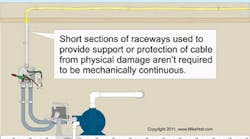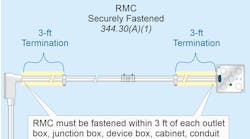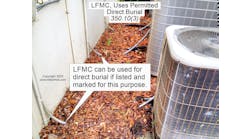All questions and answers are based on the 2011 NEC.
Q. Is it allowable to install a cable wiring method inside a circular raceway for a short distance for support or protection?
A. The general rule covering the mechanical continuity of raceways requires that raceways and cable sheaths must be mechanically continuous between boxes, cabinets, and fittings [300.12]. However, there are a couple of exceptions to note:
Ex 1: Short sections of raceways used to provide support or protection of cable from physical damage aren’t required to be mechanically continuous [250.86 Ex 2 and 300.10 Ex 1], as shown in Fig. 1.
Ex 2: Raceways at the bottom of open-bottom equipment, such as switchboards, motor control centers, and transformers, aren’t required to be mechanically secured to the equipment.
When raceways are stubbed into an open-bottom switchboard, the raceway, including the end fitting, can’t rise more than 3 in. above the bottom of the switchboard enclosure [408.5].
Q. Is it permissible to lengthen the conductors by splicing them inside the panelboard when changing out a service?
A. Section 312.8 allows cabinets, cutout boxes, and meter socket enclosures to be used for conductors as feeding through, spliced, or tapping off to other enclosures, switches, or overcurrent devices where all of the following conditions are met:
1) The total area of the conductors at any cross section doesn’t exceed 40% of the cross-sectional area of the space.
2) The total area of conductors, splices, and taps installed at any cross section doesn’t exceed 75% of the cross-sectional area of that space.
3) A warning label on the enclosure identifies the disconnecting means for feed-through conductors.
Q. When low-voltage thermostat cable is used for connecting the photo eye used as a sensor to reverse a garage door opener in a commercial occupancy, must it be installed in a raceway?
A. Only those sections contained in Art. 300 specifically referenced in 725.3 apply to Class 1, 2, and 3 circuits [725.3]. Boxes or other enclosures aren’t required for Class 2 or Class 3 splices or terminations because Art. 725 doesn’t reference 300.15, which contains these requirements.
If installed in a raceway, 725.3(A) requires that the number and size of conductors or cables in a raceway be limited in accordance with 300.17. Raceways must be large enough to permit the installation and removal of conductors without damaging conductor insulation. When all conductors in a raceway are the same size and insulation, the number of conductors permitted can be found in Annex C for the raceway type.
Article 725 does not require that Class 2 or 3 conductors be installed in a Chapter 3 wiring method, such as a raceway. Equipment and cabling must be installed in a neat and workmanlike manner, according to 725.24. Exposed cables must be supported by the structural components of the building so that the cable won’t be damaged by normal building use. Such cables must be secured by straps, staples, hangers, cable ties, or similar fittings designed and installed in a manner that won’t damage the cable. Raceways and cables can be supported by independent support wires attached to the suspended ceiling in accordance with 300.11(A).
In summary, Class 2 and 3 conductors are not required to be installed in a raceway unless it is for protection or if specific requirements of a location, such as a hazardous classified location, would require the use of a raceway.
Q. Are receptacle outlets allowed above a suspended lay-in tile ceiling for cord-connected loads, such as temporary holiday lighting displays?
A. Not if the lighting makes use of flexible cords. According to 400.8(5), flexible cords must not be concealed by walls, floors, or ceilings, or located above suspended or dropped ceilings.
Here are two other items to keep in mind:
- Flexible cords are permitted under a raised floor (with removable panels) used for environmental air, because this area isn’t considered a concealed space. See the definition of “Exposed” in Art. 100.
- Receptacles are permitted above a suspended ceiling, but a flexible cord isn’t. Why install a receptacle above a ceiling if the flexible cord isn’t permitted in this space? Because the receptacle can be used for portable tools; it just can’t be used for cord- and plug-connected equipment fastened in place, such as a projector.
Q. Are communication and computer networking cables required to be listed for use in wet locations per 310.10(C) when installed in an underground raceway as covered by 300.5(B)?
A. The requirements in 310.10(C) that conductors installed in underground raceways must be listed for wet locations does not apply to underground communications cables entering buildings [800.47]. Remember that communications systems aren’t subject to the general requirements contained in Chapters 1 through 4 or the special requirements of Chapters 5 through 7, except where a Chapter 8 rule specifically refers to one of those chapters [90.3]. Also, installations of communications equipment under the exclusive control of communications utilities located outdoors, or in building spaces used exclusively for such installations, are exempt from the NEC [90.2(B)(4)].
Q. What are the overcurrent protection and conductor sizing requirements for a transformer with a primary voltage of less than 600V?
A. Overcurrent protection for transformers rated not more than 600V is covered by 450.3(B). The primary winding of a transformer must be protected against overcurrent in accordance with the percentages listed in Table 450.3(B) and all applicable notes.
Q. Is GFCI protection required for electric hand dryers in a public restroom?
A. GFCI protection is required for all 15A and 20A, 125V receptacles installed in the “other than dwelling unit” locations listed in 210.8(B). This includes the bathroom receptacles mentioned in 210.8(B)(1), but does not include any hard-wired equipment, such as hand dryers. Only if the hand dryer is cord- and plug-connected to a 125V rated 15A or 20A receptacle does it require GFCI protection.
Remember, a 15A or 20A, 125V receptacle isn’t required in a commercial or industrial bathroom, but if one is installed, it must be GFCI protected.
Q. Are 240V receptacles installed in a dwelling unit garage required to have GFCI protection?
A. GFCI protection for dwelling units is required for all 15A and 20A, 125V receptacles located in the locations listed in 210.8(A), which includes garages and accessory buildings [210.8(A)(2)]. There is no requirement for GFCI protection in these locations for receptacles rated more than 125V, such as 240V receptacles.
Q. In a commercial occupancy, does the Code require each office to have its own separate light switch to control the luminaires?
A. In non-dwelling locations, the installation of light switches is not generally specified by the Code, although 210.70(C) does address the requirements for switches to control lighting where the illumination is needed to service equipment. According to 210.70(C), at least one lighting outlet that contains a switch or is controlled by a wall switch must be installed in attics and underfloor spaces containing equipment that requires servicing. The switch must be located at the usual point of entry to these spaces, and the lighting outlet must be located at or near the equipment requiring servicing. In addition, a 15A or 20A, 125V receptacle must be installed within 25 ft of heating, air-conditioning, and refrigeration equipment [210.63].
While the NEC doesn’t require that each office have its own separate light switch, there are other codes that could apply. For example, where adopted, ASHRAE/IES 90.1-2010 has lighting control requirements not found in the NEC.
Q. What are the GFCI protection requirements for a 15A or 20A, 125V receptacle outlet on the dwelling unit laundry circuit?
A. For other than kitchen sinks, GFCI protection is required for all 15A and 20A, 125V receptacles located within an arc measurement of 6 ft from the outside edge of the sink [210.8(A)(7)], as shown in Fig. 2. If the laundry receptacle is located beyond this 6-ft arc, there are no other Code requirements that require it to be GFCI-protected.




